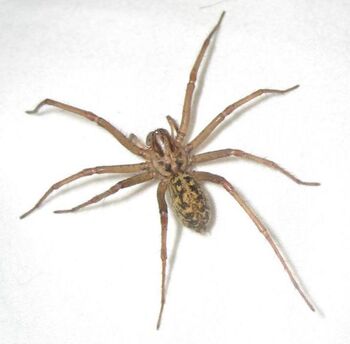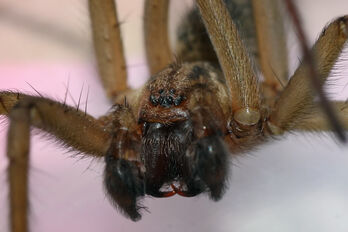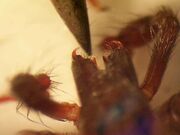
The hobo spider (Tegenaria agrestis) is a member of the genus of spiders known colloquially as funnel web spiders, but not to be confused with the Australian funnel-web spider. It is one of a small number of spiders whose bites are generally considered to be medically significant. Individuals construct a funnel-shaped structure of silk sheeting and lie in wait at the small end of the funnel for prey insects to blunder onto their webs. Hobo spiders sometimes build their webs in or around human habitations. This species of spider has a reputation for aggressiveness, due to its poor eyesight. They will normally avoid contact with humans unless accidentally crushed or squeezed. The spider's venom is strong enough to cause considerable local pain and, possibly, necrosis.
Habitat and History
Europe
The hobo spider is native to Europe, where it is a resident of fields, rarely entering human habitations due to the presence of major competitors, particularly the giant house spider (Tegenaria duellica) which is a common resident of houses and other man-made structures in Europe. As a result human contacts with the hobo spider are uncommon in Europe. The species was first described in 1802 by naturalist C.A. Walkenaer, under the name Aranea agrestis, in reference to its western European habitat in fields, woods, and under rocks.
North America
Tegenaria agrestis is a non-native species in the United States, where it was introduced to the Pacific Northwest from Western Europe. It is believed to have first appeared in the port city of Seattle sometime before the 1930s. There is speculation that it arrived as eggs in commercial agricultural shipments from Europe, since isolated adults in shipments would have had difficulty in establishing a breeding population. It was first reported in the U.S. in 1936 by arachnologist Harriet Exline (as Tegenaria magnacava). There, without the widespread presence of any dominant competitors, it rapidly adapted to living in urban areas, where it became abundant and extended its range. By 1968 it had become established as far east as Spokane, Washington, and Moscow, Idaho, and as far south as Roseburg, Oregon. Hobo spiders have also been found in other western states, such as Utah, where they are commonly found inside of homes.
(Two other closely related spiders live in Washington state, the giant house spider (Tegenaria duellica, or alternatively Tegenaria gigantea) and the barn funnel weaving spider or domestic house spider (Tegenaria domestica). All three of these spiders originated in Europe.)
Identification

, Spiders including the hobo spider, vary considerably in appearance, and identification can be difficult. Identification relies on an examination of the spider’s anatomy. Positive identification requires microscopic examination of the epigynum and palps and is best done by an Arachnologist. However, the following characteristics can help in identification of hobo spiders in order to prevent misidentification and eradication of beneficial species with a similar general appearance:
- Hobo spiders lack the colored bands found on many spiders of the Agelenidae family where the leg joints meet.
- The abdomen has chevron (V-shaped) patterns (possibly many of them) down the middle, with the chevrons pointing towards the head.
- Like other funnel spiders, hobo spiders have two spinnerets extending from the bottom of the abdomen.
- Hobo spiders have a light stripe running down the middle of the sternum. If the spider instead has three or four pairs of light spots on the lateral portions of the sternum, then it is one of the other two related Tegenaria species. However absence of spots is not conclusive proof that the spider is a hobo spider, since the spots on other Tegenaria species may be extremely faint and not readily visible.
- Hobo spiders do not have two distinct longitudinal dark stripes on the top side of the cephalothorax, instead showing indistinct or diffused patterns. Washington spiders with distinct dark stripes include spiders from the genuses Agelenopsis and Hololena and possibly some wolf spiders. (These spiders do not have common names.)
Toxicity and aggression
The toxicity and aggression of the hobo spider are currently disputed by arachnologists. One common name, the aggressive house spider may arise from a misinterpretation of the Latin name agrestis, (lit. "of the fields") as "aggressive". If a hobo spider is tending an egg sac, it may become aggressive if it perceives the egg sac as being threatened. However, they generally do not bite unless forced to protect themselves.

In the United States, the hobo spider has been considered to be a dangerous species based on a toxicology study on rabbits where lesions appeared after spiders were induced to bite the rabbits. This laboratory study has led to the proposal that in some parts of the U.S. nearly all bites attributed to the brown recluse spider are in reality the hobo spider's bite. The CDC and other U.S. government agencies have also used this same study as the basis for a report claiming that the hobo spider bite causes necrosis in humans, despite the absence of any confirmed cases. Subsequent attempts to replicate the study by injecting sufficient venom to ensure envenomation have failed to produce necrotic lesions, and there is even question as to whether the lesions observed in the original study were necrotic.
In Canada, there are scientists who claim that no hobo spider bites lead to dermal necrosis. Hobo spiders are common in Europe, though bites are relatively unknown, and there are no confirmed reports of them causing necrosis despite hundreds of years of coexistence there. The only documented case of a verified hobo spider bite leading to necrotic skin lesions involves a person who had a pre-existing medical condition (phlebitis) that can also cause the appearance of skin lesions.
Hobo spider bites are not known to be fatal to healthy humans. The necrosis in purported cases is similar to, but milder than, that caused by the brown recluse spider, and in severe cases can take months to heal. Other reported symptoms include intense headaches, vision abnormalities, and/or general feelings of malaise. These symptoms are not confirmed for the hobo spider bite specifically due to lack of positive identification of the spider by an expert, and the Oregon Poison Center (affiliated with the Oregon Health & Science University) is attempting to gather definitive evidence regarding the validity of these reports as of September 2007.
